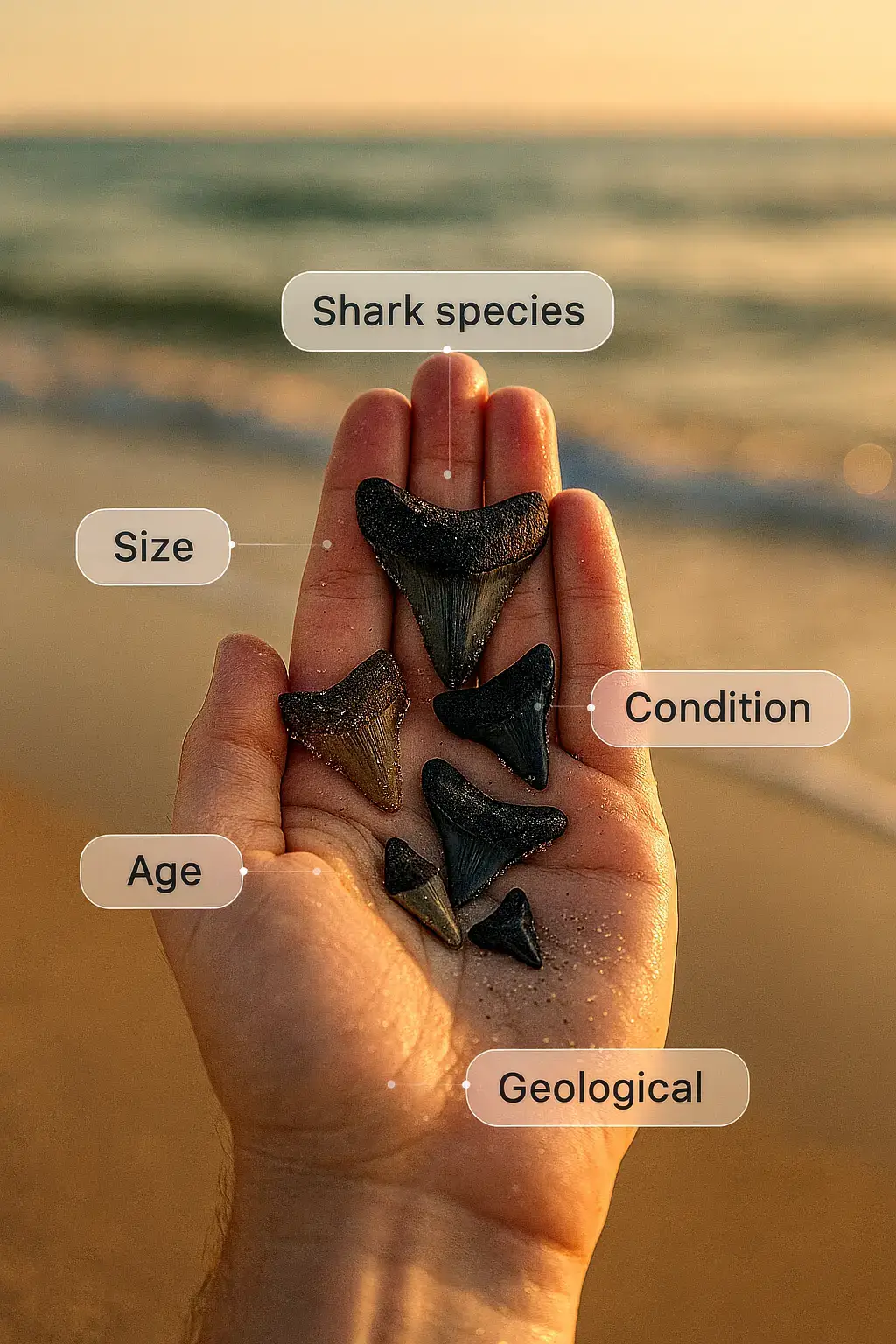Identify Megalodon Teeth with AI-Powered Recognition Technology
Master the art of Megalodon tooth identification using our comprehensive guide and AI-powered shark tooth identifier app. Learn size ranges, serration patterns, and authenticity markers for prehistoric specimens.

Complete Guide to Megalodon Tooth Identification
Identify Megalodon teeth with confidence using our comprehensive identification guide and AI-powered shark tooth identifier app. The prehistoric Megalodon (Carcharocles megalodon) was the largest shark that ever lived, reaching lengths of up to 60 feet, and its massive teeth are among the most sought-after fossils for collectors worldwide.
Key Physical Characteristics of Megalodon Teeth
Megalodon tooth identification begins with understanding their distinctive size and morphology. These prehistoric giants possessed teeth ranging from 3 to 7 inches in length, with some exceptional specimens reaching up to 7.5 inches. The massive size immediately distinguishes them from modern shark teeth – a Great White shark tooth typically measures only 1-2 inches, making Megalodon teeth 3-5 times larger.
The shape of Megalodon teeth is broadly triangular with a wide base tapering to a sharp point. Upper teeth tend to be more triangular and symmetrical, while lower teeth are often narrower and more blade-like. The serration pattern is crucial for identification – authentic Megalodon teeth display fine, regular serrations along both cutting edges, with approximately 10-15 serrations per centimeter.
Color and Fossilization Characteristics
Genuine Megalodon teeth exhibit distinctive fossilization characteristics that aid in identification. The color typically ranges from dark gray to black, though some specimens display brown, tan, or even blue-gray hues depending on the minerals present during fossilization. The tooth surface should feel heavy and solid due to mineral replacement – a lightweight tooth is often a replica or fake.
Authentic fossil Megalodon teeth often display root coloration different from the crown. While the crown (cutting portion) may be dark, the root typically appears lighter, ranging from tan to reddish-brown. This color variation is a natural result of the fossilization process and helps authenticate genuine specimens.
Geographic Distribution and Collection Locations
Identify Megalodon teeth in specific geographic regions where these prehistoric sharks once thrived. The southeastern United States offers the most productive collecting areas, particularly Florida's coastline. Venice Beach, Florida, known as the "Shark Tooth Capital of the World," consistently yields Megalodon specimens along with numerous other shark teeth species.
North Carolina's coastal areas, especially near Cape Hatteras and the Outer Banks, provide excellent opportunities for Megalodon tooth discovery. South Carolina's beaches, particularly around Myrtle Beach and Folly Beach, also produce quality specimens. California's coastal regions, especially around Central California, offer additional collecting opportunities for West Coast enthusiasts.
Size Classification and Quality Assessment
Megalodon teeth are typically classified by size into several categories. Small specimens measure 3-4 inches, medium teeth range from 4-5 inches, large teeth span 5-6 inches, and exceptional specimens exceed 6 inches. The quality assessment considers completeness, with perfect teeth showing no chips or breaks along the edges, while good condition teeth may have minor imperfections.
The preservation quality significantly impacts identification confidence and value. Premium specimens display complete serration patterns, intact root systems, and minimal wear. Our shark tooth identifier app can assess these quality factors instantly through AI-powered image analysis, providing detailed condition reports for your Megalodon tooth discoveries.
Common Misidentifications and Similar Species
Several shark species produce teeth that novice collectors might mistake for Megalodon specimens. Great White shark teeth share similar triangular shapes but are significantly smaller and typically lighter in color. Tiger shark teeth display curved shapes with pronounced serrations but lack the massive size of Megalodon teeth. Bull shark teeth are triangular but much smaller and often broader relative to their height.
Modern replica Megalodon teeth pose identification challenges for collectors. Authentic fossilized teeth display natural wear patterns, mineral deposits, and weight characteristics that replicas cannot perfectly mimic. Our AI-powered identification system has been trained to recognize these subtle authenticity markers, providing reliable verification for your fossil discoveries.
Advanced Identification Techniques
Professional Megalodon tooth identification involves examining several microscopic features. The dentin structure within the tooth shows characteristic patterns under magnification. Authentic fossils display natural mineral infiltration patterns that create unique internal structures. The weight distribution should feel balanced, with the root portion providing substantial mass.
Surface texture analysis reveals important authenticity markers. Genuine Megalodon teeth often display natural etching from millions of years of chemical weathering. These micro-patterns are nearly impossible to replicate artificially and provide strong evidence of authenticity when present.
Explore Other Shark Species Identification
Master identification techniques for popular shark species with our comprehensive guides
Identify Great White Shark Teeth
Learn to identify Great White shark teeth using size, serration patterns, and morphological features.
Learn More →Identify Tiger Shark Teeth
Master Tiger shark tooth identification with curved shapes and distinctive serration patterns.
Learn More →Identify Bull Shark Teeth
Understand Bull shark tooth characteristics including triangular shapes and broad bases.
Learn More →Frequently Asked Questions About Megalodon Identification
How can I identify authentic Megalodon teeth?
Authentic Megalodon teeth are typically 3-7 inches long, have a triangular shape with serrated edges, and display fossilization characteristics like dark coloration and mineralized weight. Use our AI-powered app for instant verification.
What size are Megalodon teeth compared to other sharks?
Megalodon teeth range from 3-7 inches in length, making them significantly larger than modern shark teeth. Great White teeth typically measure 1-2 inches, making Megalodon teeth 3-5 times larger.
Where are Megalodon teeth most commonly found?
Megalodon teeth are commonly found on beaches in Florida, North Carolina, South Carolina, and California. Venice Beach in Florida is particularly famous for Megalodon tooth discoveries.
Start Identifying Megalodon Teeth Today
Download our AI-powered shark tooth identifier app and instantly identify Megalodon teeth with 95% accuracy. Perfect for collectors, beachcombers, and fossil enthusiasts.
Download Free App